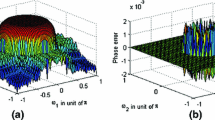Abstract
This paper focuses on the design of two-dimensional (2D) quadrantally symmetric finite impulse response (FIR) filters, and presents three very efficient algorithms for the weighted least squares (WLS) design with a weight matrix that assigns four different weights to four different frequency bands. The first algorithm seeks for iterative solutions to the matrix equation describing the optimality condition of the design problem. The second algorithm aims at the limit solution of the solution sequence to the first algorithm, analytically obtained by using matrix diagonalization techniques. The third algorithm belongs to the category of iterative reweighting techniques. It uses the second algorithm as its iteration core, and aims at reducing the maximum magnitude error of the filter by iteratively adjusting the four entry values of the weight matrix. Design examples are provided to demonstrate the performance of the proposed algorithms.
Similar content being viewed by others
References
J. S. Lim. Two-dimensional Signal and Image Processing. Englewood Cliffs: Prentice-Hall, 1990.
W. Lu, A. Antoniou. Two-dimensional Digital Filters. New York: Marcel Dekker, 1992.
M. O. Ahmad, J. Wang. An analytic least mean square solution to the design problem of two-dimensional FIR filters with quadrantally symmetric or antisymmetric frequency response. IEEE Transactions on Circuits and Systems, 1989, 36(7): 968–979.
W. Zhu, M. O. Ahmad, M. N. S. Swamy. A closed-form solution to the least-square design problem of 2-D linear-phase FIR filters. IEEE Transactions on Circuits and Systems — II, 1997, 44(12): 1032–1039.
W. Zhu, M. O. Ahmad, M. N. S. Swamy. A least-square design approach for 2-D FIR filters with arbitrary frequency response. IEEE Transactions on Circuits and Systems — II, 1999, 46(8): 1027–1034.
M. T. Hanna. Weighted least squares design of two-dimensional zero-phase FIR filters in the continuous frequency domain. IEEE Transactions on Circuits and Systems — II, 1996, 43(7): 534–537.
C. H. Hsieh, C. M. Kuo, Y. D. Jou, et al. Design of two-dimensional FIR digital filters by a two-dimensional WLS technique. IEEE Transactions on Circuits and Systems — II, 1997, 44(5): 348–358.
J. L. Aravena, G. Gu. Weighted least mean square design of 2-D FIR digital filters: the general case. IEEE Transactions on Signal Processing, 1996, 44(10): 2568–2578.
R. Zhao, X. Lai. A fast matrix iterative technique for the WLS design of 2-D quadrantally symmetic FIR filters. Multidimensional Systems and Signal Processing, 2011, 22(4): 303–317.
E. Gilason, M. Johansen, K. Conradsen, et al. Three different criteria for the design of two-dimensional zero phase FIR digital filters. IEEE Transactions on Signal Processing, 1993, 41(10): 3070–3074.
W. Lu. A unified approach for the design of 2-D digital filters via semidefinite programming. IEEE Transactions on Circuits and Systems — I, 2002, 49(6): 814–826.
X. Lai. Design of smallest size two-dimensional linear-phase FIR filters with magnitude error constraint. Multidimensional Systems and Signal Processing, 2007, 18(4): 341–349.
X. Lai, Y. Cheng. A sequential constrained least-square approach to minimax design of 2-D FIR filters. IEEE Transactions on Circuits and Systems — II, 2007, 54(11): 994–998.
W. Lu, T. Hinamoto. Two-dimensional digital filters with spares coefficients. Multidimensional Systems and Signal Processing, 2011, 22(1): 173–189.
J. J. Shyu, S. Pei, Y. Huang. An iterative approach for minimax design design of multidimensional quadrature mirror filters. Signal Processing, 2011, 91(8): 1730–1740.
Y. D. Jou, C. H. Hsieh, C. M. Kuo. Efficient weighted least-squares algorithm for the design of FIR filters. IEE Proceedings Vision, Image and Signal Processing, 1997, 144(4): 244–248.
R. A. Horm, C. R. Johnson. Matrix Analysis. Cambridge: Cambridge University Press, 1985.
Author information
Authors and Affiliations
Corresponding author
Additional information
This work was partly supported by the National Nature Science Foundation of China (Nos. 61175001, 60974102), partly by the National Basic Research Program of China (Nos. 2012CB821200, 2009CB320600), and partly by the Shandong Provincial Nature Science Foundation of China (No. ZR2010FQ016). This work has been appeared in the 30th Chinese Control Conference (CCC), held in Yantai, Shandong.
Ruijie ZHAO received his B.S. and M.S. degrees from Shandong University, China, in 2001 and 2004, respectively. He has been with Shandong University since 2004, where he became a lecturer in 2006. His main research interests include digital filter design, optimization algorithm, and approximation theory.
Xiaoping LAI received his B.S., M.S., and Ph.D. degrees from Shandong University, China, in 1985, 1988, and 2000, respectively, and became a professor in 2001. He was with Shandong University from 1988 to 2008, and has been with Hangzhou Dianzi University since January 2008. His main research interests include digital filter design, optimization, and artificial neural networks.
Rights and permissions
About this article
Cite this article
Zhao, R., Lai, X. Fast two-dimensional weighted least squares techniques for the design of two-dimensional finite impulse response filters. J. Control Theory Appl. 11, 180–185 (2013). https://doi.org/10.1007/s11768-013-1119-x
Received:
Revised:
Published:
Issue Date:
DOI: https://doi.org/10.1007/s11768-013-1119-x




